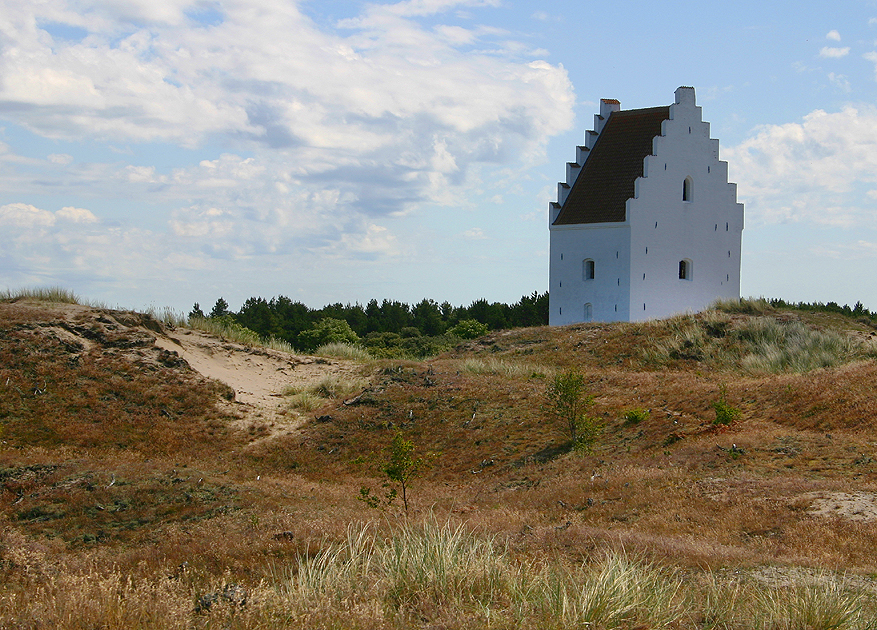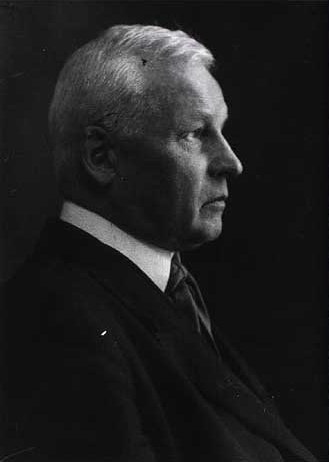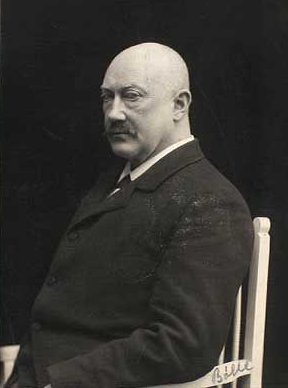|
Skagen Museum
Skagens Museum is an art museum in Skagen, Denmark, that exhibits an extensive collection of works by members of the colony of Skagen Painters who lived and worked in the area in the late 19th and early 20th centuries. Important artists include Marie and P. S. Krøyer, Anna and Michael Ancher, Laurits Tuxen, Viggo Johansen, and Holger Drachmann. The museum also hosts special exhibitions. Its facilities include a café in the Garden House, an old building which for a while served as home residence and studio of Anna and Michael Ancher. History Skagens Museum was founded on 20 October 1908 in the dining room at Brøndums Hotel. Among the founders were artists Michael Ancher, P.S. Krøyer and Laurits Tuxen, who were elected to form the first board of governors together with Victor Christian Klæbel, the local pharmacist, and Degn Brøndum, proprietor of Brøndums Hotel and Anna Ancher's brother. The idea was to collect works by the Skagen Painters and to raise funds for the constr ... [...More Info...] [...Related Items...] OR: [Wikipedia] [Google] [Baidu] |
Skagen
Skagen () is Denmark's northernmost town, on the east coast of the Skagen Odde peninsula in the far north of Jutland, part of Frederikshavn Municipality in Nordjylland, north of Frederikshavn and northeast of Aalborg. The Port of Skagen is Denmark's main fishing port and it also has a thriving tourist industry, attracting 2 million people annually. The name was applied originally to the peninsula but it now also refers to the town. The settlement began during the Middle Ages as a fishing village, renowned for its herring industry. Thanks to its seascapes, fishermen and evening light, towards the end of the 19th century it became popular with a group of impressionist artists now known as the Skagen Painters. In 1879, the Skagen Fishermen's Association was established with the purpose of facilitating the local fishing industry through the Skagensbanen railway, which opened as a narrow-gauged railway in 1890. The modern port of Skagen opened on 20 November 1907, and with ... [...More Info...] [...Related Items...] OR: [Wikipedia] [Google] [Baidu] |
Ulrik Adolph Plesner
Ulrik Adolph Plesner, usually known as Ulrik Plesner (17 May 1861 in Vedersø – 22 November 1933 in Skagen) was an innovative Danish architect who designed in a National Romantic style at the beginning of the 20th century. He is remembered in particular for his influence on the style of architecture practiced in Skagen in the north of Jutland."Ulrik Plesner, f. 1861" ''Dansk Biografisk Leksikon''. Retrieved 12 October 2013. Early life Born in Vedersø near on the west coast of Jutland, he was the son of parish priest J.F. Plesner. After attending the Copenhagen Technical School (''Teknisk Selskabs Skole''), he ...[...More Info...] [...Related Items...] OR: [Wikipedia] [Google] [Baidu] |
Klitgården
Klitgaarden ( lit. "The Dune House") is a former summer residence of the Danish royal family situated just south of Skagen on the northern tip of Jutland. The house was designed by Ulrik Plesner for King Christian X and Queen Alexandrine and completed in 1914. It is now owned and run by a trust and serves as a retreat for artists and scientists. History When Prince Christian married Alexandrine of Mecklenburg-Schwerin at a low-key ceremony in Cannes in 1898, the couple was given Marselisborg Palace just south of Aarhus as a summer residence by Aarhus Municipality. However, the princess fell in love with the scenic and exotic area around Skagen. For the last couple of decades the town had played host to a thriving artists colony of Skagen painters and since 1890, when it was connected by train to Frederikshavn, it had developed into a mondain summer destination. Prince Christian became crown prince of Denmark in January 1906 and when the couple attended the inauguration of the ne ... [...More Info...] [...Related Items...] OR: [Wikipedia] [Google] [Baidu] |
European Regional Development Fund
The European Regional Development Fund (ERDF) is one of the European Structural and Investment Funds allocated by the European Union. Its purpose is to transfer money from richer regions (not countries), and invest it in the infrastructure and services of underdeveloped regions. This will allow those regions to start attracting private sector investments, and create jobs on their own. History During the 1960s, the European Commission occasionally tried to establish a regional fund, but only Italy ever supported it. Britain made it an issue for its accession in 1973, and pushed for its creation at the 1972 summit in Paris. Britain was going to be a large contributor to the CAP and the EEC budget, and sought to offset this deficit by having the ERDF established. They would then be able to show their public some tangible benefits of EEC membership. The ERDF was set to be running by 1973, but the 1973 oil crisis delayed it, and it was only established in 1975 under considerable Brit ... [...More Info...] [...Related Items...] OR: [Wikipedia] [Google] [Baidu] |
Gothenburg Museum Of Art
Gothenburg Museum of Art ( sv, Göteborgs konstmuseum) is located at Götaplatsen in Gothenburg, Sweden. It claims to be the third largest art museum in Sweden by size of its collection. Collections The museum holds the world's finest collection of late 19th century Nordic countries, Nordic art. A highlight is the lavishly decorated Fürstenberg Gallery, named after a leading Gothenburg art donor, Pontus Fürstenberg and his wife Göthilda. Among the artists showcased are Peder Severin Krøyer, P.S. Krøyer, Carl Larsson, Bruno Liljefors, Edvard Munch, and Anders Zorn. The museum also houses older and contemporary art, both Nordic and international. The collection includes, for example, Monet, Picasso and Rembrandt. The Museum has been awarded three stars in the Michelin Green Guide (Green Guide Scandinavia). Architecture The museum building was designed for the Gothenburg Exhibition (1923), Gothenburg Exhibition (''Jubileumsutställningen i Göteborg'') in 1923 by architect ... [...More Info...] [...Related Items...] OR: [Wikipedia] [Google] [Baidu] |
Google Art Project
Google Arts & Culture (formerly Google Art Project) is an online platform of high-resolution images and videos of artworks and cultural artifacts from partner cultural organizations throughout the world. It utilizes high-resolution image technology that enables the viewer to tour partner organization collections and galleries and explore the artworks' physical and contextual information. The platform includes advanced search capabilities and educational tools. A part of the images are used within Wikimedia and Wikipedia. Collections in Wikimedia The following list of collections is based on c:Google Art Project works by collection, the Wikimedia category Google Art Project works by collection. The "Visit" link redirects to the museum's official page on the Google Arts & Culture platform. See alscollections in Google Arts & Culture The "Assigned works" link redirects to the images of the works shown in this collection available in Wikimedia. Painters in Wikimedia The following ... [...More Info...] [...Related Items...] OR: [Wikipedia] [Google] [Baidu] |
Michael And Anna Ancher House
Anchers Hus is an art museum and gallery situated in the former residence of the painters Michael and Anna Ancher in Skagen, Denmark. Anchers Hus is located on Markvej in Skagen, Denmark. History Michael Ancher (1849-1927) and Anna Ancher (1859-1935) were both central figures in the artist colony of Skagen Painters who lived and worked in the town during late 19th and early 20th century. After their marriage in 1880, Michael and Anna Ancher took up residency in the Garden House near Brøndums Hotel which was owned by Anna's parents. The Garden House is now a part of Skagens Museum. The house on Markvej was purchased in 1884. In 1913, a large annex was added to the property with studios, kitchen, living and bed rooms. They lived in the house for five decades and in 1913 expanded it with a studio annex designed by architect Ulrik Plesner (1861-1933) another member of the colony. The house now serves as a historic house museum and displays a large numbers of their own works an ... [...More Info...] [...Related Items...] OR: [Wikipedia] [Google] [Baidu] |
Lazaretto
A lazaretto or lazaret (from it, lazzaretto a diminutive form of the Italian word for beggar cf. lazzaro) is a quarantine station for maritime travellers. Lazarets can be ships permanently at anchor, isolated islands, or mainland buildings. In some lazarets, postal items were also disinfected, usually by fumigation. This practice was still being done as late as 1936, albeit in rare cases. A leper colony administered by a Christian religious order was often called a lazar house, after the parable of Lazarus the beggar. Throughout history In 1592, a lazaretto made of wooden huts was built on Manoel Island in Malta during a plague epidemic. It was pulled down in 1593 after the disease had subsided. In 1643, Grandmaster Lascaris built a permanent Lazzaretto in the same place to control the periodic influx of plague and cholera on board visiting ships. The hospital was subsequently improved over time, and was enlarged during the governorship of Sir Henry Bouverie ... [...More Info...] [...Related Items...] OR: [Wikipedia] [Google] [Baidu] |
Frieze
In architecture, the frieze is the wide central section part of an entablature and may be plain in the Ionic or Doric order, or decorated with bas-reliefs. Paterae are also usually used to decorate friezes. Even when neither columns nor pilasters are expressed, on an astylar wall it lies upon the architrave ("main beam") and is capped by the moldings of the cornice. A frieze can be found on many Greek and Roman buildings, the Parthenon Frieze being the most famous, and perhaps the most elaborate. This style is typical for the Persians. In interiors, the frieze of a room is the section of wall above the picture rail and under the crown moldings or cornice. By extension, a frieze is a long stretch of painted, sculpted or even calligraphic decoration in such a position, normally above eye-level. Frieze decorations may depict scenes in a sequence of discrete panels. The material of which the frieze is made of may be plasterwork, carved wood or other decorative medium. ... [...More Info...] [...Related Items...] OR: [Wikipedia] [Google] [Baidu] |
Thorvald Bindesbøll
Thorvald Bindesbøll (21 July 1846 – 27 August 1908) was a Danish National romantic architect, sculptor and ornamental artist. He designed the Dragon Fountain, Copenhagen (''Dragespringvandet'') and is perhaps best known as the creator of the Carlsberg beer label, which has remained unchanged since it was introduced. Biography Bindesbøll was born in Copenhagen, Denmark. Born into an artistic family; he was the son of architect Michael Gottlieb Bindesbøll (1800–1856) and wife Andrea Frederikke Andersen (1819-1899). His sister Johanne Bindesbøll was a successful textile artist. He attended the Royal Danish Academy of Fine Arts and left as an architect in 1876. Marginalized as an architect, Bindesbøll turned increasingly towards the art of craftsmanship. As early as 1880, he came into the field of pottery encouraged by the friend and architect Andreas Clemmensen. He began producing ceramics at Frauens Levarefabrik. He worked at Johan Wallmann in Utterslev 1883–90 ... [...More Info...] [...Related Items...] OR: [Wikipedia] [Google] [Baidu] |




